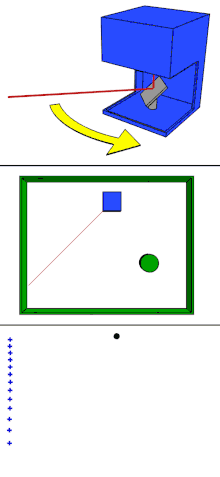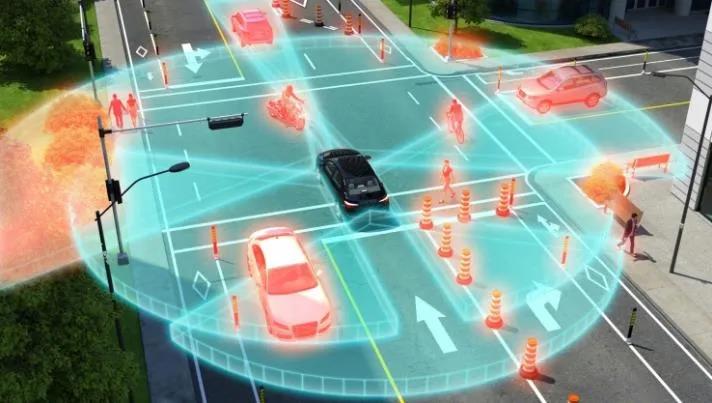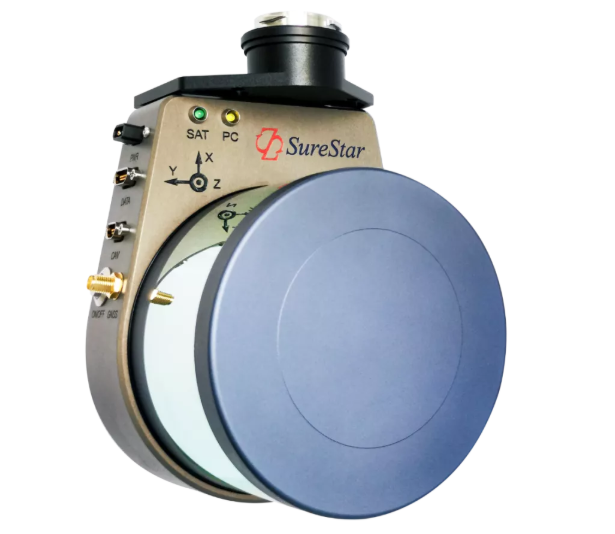High price, large size, and difficulty in mass production. Have these shackles that have been plaguing and hindering the development of lidar have been broken? Last year, a set of 128-line laser radar in the United States sold for 90,000 US dollars. What is the price of Surestar's 256-line laser radar now? What is the technological route of lidar? Which one is closer to the vehicle-grade level, so as to help the lidar "get on the car" for mass production?
In terms of performance, the 256-line products meet the requirements of long-distance perception and discrimination of people, vehicles and objects when the vehicle is running at high speed. Taking at least 5 points in both vertical and horizontal directions as the stable detection standard, the resolution of 0.1°×0.1° can increase the effective ranging to nearly 200m, and the 150° horizontal field of view can be used in difficult scenarios such as unprotected left turns of autonomous vehicles. It provides a wide field of view, so as to take care of oncoming vehicles or pedestrians on the right, while the ultra-high frame rate can quickly capture abnormal events, and the fine grayscale recognition can provide strong lane line perception capabilities.
Let's take a look at the parameters of this 256-line lidar:

Looking at the current vehicle lidar market, it can be found that several giant companies in the world have followed closely behind, adopting the micro-rotating mirror technology route in their products, but in terms of wire harnesses, Surestar has achieved 256 lines, and no one can reach.
Surestar's C-Fans series products are aimed at the front-loading mass production market, taking into account performance, reliability and longevity. We have passed 16949 (automotive industry quality management certification system), and passed a series of vehicle regulation reliability experiments under the "ISO 16750" standard. C-Fans have experienced the severe test of field users placing it in the extreme cold of the Northeast at minus 40 degrees and on unstructured roads where the car body is exposed to more than 70 degrees in the Gobi in summer. C-Fans has been installed on the road end for more than a year since it was installed on the road side by the user in cooperation with the road. It has experienced wind, frost, rain, snow, sun and rain without any problems.
In terms of price, the unit price of 100,000 units of Surestar's 256 line products reported to car companies is enough to surprise people. It can be said that Surestar has fully prepared for the mass production of car gauges.
Vehicle LiDAR boarding process is accelerated
In recent years, there have been many innovative entrepreneurs in the field of LiDAR detectors at home and abroad, and a large number of players have poured in. They all hope to bring LiDAR into every vehicle, realize capital, and let the industry land. This has become a new trend in the development of the automotive industry.
It is worth mentioning that many leading technology companies in other fields have also turned to the field of lidar. After trying various technical routes to explore and experiment, most industry giants have chosen a multi-faceted prism scanning technology system similar to Surestar C-Fans, also known as "micro-rotating mirror scanner framework", which makes Surestar felt both relief and pressure.
Around 2017, as long as the lidar is made, the entrepreneurial team will not be unable to raise money, and it is very easy to start with at least 10 million yuan and 30 million yuan. In the past two years, it was sought after by hot capital, and lidar was very popular. At least hundreds of lidar start-up companies were born in China.
Under the pursuit of capital, there are ripples in the field of automotive lidar, and the news of various lidar "on the car" tests are publicized on the screen, impacting people's attention. After all, the mass production of lidar and automobiles on the production line is the ultimate goal of vehicle lidar, otherwise it will be regarded as bragging by the industry.
At present, vehicle-mounted lidar is still in the early stage of industrial development, and the debate on the technological development path has not been finalized. For example, Tesla has always relied on computer vision technology and used in-vehicle cameras to implement related autonomous driving assistance technologies. One of the reasons Tesla didn't go the lidar route was to keep costs in check. However, "In terms of intelligent driving, Tesla can only be counted as assisted driving, not high-level automatic driving." Zhiwu Zhang said.
With the continuous advancement of technology, from the new "expensive" to the new "favorite", and then to the top of the station, the prospect of lidar is attractive. Data shows that by 2022, the global lidar market is expected to reach 5 billion US dollars, and it is expected to exceed 80 billion US dollars in 2035. It can be seen that the automotive lidar market is large enough. Therefore, aiming at the automotive pre-installation market and laying out vehicle-grade products is also a logical development direction for lidar companies.
"It should be noted that, compared with the aftermarket, the pre-installation market of lidar (mass production on the production line) is a large-scale job, and it is not easy to achieve mass production." Zhiwu Zhang reminded entrepreneurs that the car factory needs to install a new model , time-consuming, labor-intensive, and money-consuming, it is a marathon full of sprints.
For example, Fu Xiaoyu, an engineer from Surestar, said that if a car has 100,000 parts and a good model will sell at least 30,000 to 100,000 cars a year, the car company must ensure that 10 of the 100,000 cars are sold. 10,000 parts are not wrong, this is called mass production.
In any case, the lidar has been pushed to the high platform, the process of "getting on the car" is accelerating, and even the arrow is on the line.
"Micro-rotating mirror" is easier to "get on"
Lidar is known as the "eye of unmanned driving" in the industry. Since 2016, with the rise of artificial intelligence and the concept of autonomous driving, lidar has been used as an essential core sensor for autonomous vehicles. Experts in the automotive industry said that in the field of high-level autonomous driving, lidar has become the main auxiliary sensor in L3-level autonomous driving mass-produced models; and for L4-L5 autonomous vehicles, lidar will become an essential main sensor.
"Actually, lidar technology is very new, and so far there is no recognized best and most mature technology system, no complete and mature supply chain, and no national standards to speak of. The entire industry is in the stage of exploration, breakthrough and re-innovation." Zhiwu Zhang said.
So, how does lidar work and what are the technical routes?
Lidar is composed of three parts: a laser transmitting and receiving system, an optical system and a signal processing system. It can help the computer on the car to quickly, efficiently and accurately capture three-dimensional images of the surrounding area, and measure the distance and speed of objects.
It works by driving the laser transmitter to actively reflect the light source (visible light and near-infrared light waves) to the detected object, and when the light returns, the lidar can calculate the distance of the object and whether the object is moving. Therefore, lidar is an indispensable and important sensor in autonomous driving, and it is the eye and all-day perception system of intelligent cars.

In terms of device structure, lidars include mechanical lidars and solid-state lidars. Specifically, the laser transmitting and receiving modules of the mechanical lidar rotate during operation, and obtain a 360° field of view by rotating, which makes the reliability and stability of the mechanical lidar poor. The large size, the inability to pass the car regulations, the complicated process, and the low production efficiency are all bottlenecks for the mass production of mechanical lidars.
Let's look at solid-state lidar. Its laser emitting and receiving modules are static in operation, but the optical mechanism can be static, and can also be driven by circuits (such as MEMS micro-galvanometers) or micro motors (such as micro-rotating mirrors) to control and adjust the angle. Among them, the MEMS technology path was once favored by many manufacturers due to the advantage of low cost.
However, at present, three bottlenecks of MEMS need to be broken through: First, its field of view is relatively small, and the field of view of a single MEMS lens is only about 30 degrees. The field of view is small and the blind spot is large, requiring multiple lidars to achieve 360-degree coverage of the horizontal field of view. Although some companies can now achieve a MEMS field of view angle of 120 degrees, they need to be assembled with 4 MEMS galvanometers, which increases the complexity of the system and the difficulty of the process. The point cloud seam generated by the overlapping galvanometers makes automatic identification Algorithm difficulty increases.
Second, its ranging capability is not enough. At present, MEMS using 905nm nano-semiconductor laser transmitters can only reach a maximum distance of 80 meters, which is far from the 200-meter ranging required for autonomous vehicles. In order to overcome this drawback, some companies use 1550nm fiber lasers to make up for it, and "expensive" fiber lasers have become a pain that the industry cannot bear.
Third, the fiber laser is not resistant to high and low temperature, and still cannot pass the vehicle regulations. In addition, huge power consumption is undoubtedly the "fatal weakness" of automotive sensors.
"For automotive consumer electronics products, there is no choice but to be cheap, compact and adaptable to the environment." Zhiwu Zhang said bluntly.
Relying on its own exploration and background of lidar for many years, Surestar "innovatively" launched the micro-rotating mirror structure of C-Fans, taking the lead in miniaturizing and solidifying the laser transmitter and receiver module and signal processing module of lidar, using micro motors Drive the polygon mirror to scan, and realize the technology path of vehicle-type lidar with large field of view, long measuring range, high resolution and low cost.
The five series of lidar signal processing chips independently developed by Surestar are the guarantee of Surestar C-Fans lidar performance and cost advantage, and also our unique core technology and capability. Surestar C-Fans-32 is currently the only lidar product that has passed the "Intrinsically Safe" certification. Contributions in this regard ensure the safety of robots and unmanned vehicles in flammable and explosive environments such as coal mines.
Zhiwu Zhang said that we have saved a lot of research and development time by not touching the technical paths with obvious theoretical defects, performance ceilings and cost bottlenecks. Surestar car-type lidar aimed at the following goals at the beginning of its design: first, cheap; second, compact; third, low power consumption; fourth, strong environmental adaptability; fifth, high reliability; sixth, suitable for large Mass production.
Lidar needs the industry chain to work together to innovate
"It's not easy to come up with a product." Zhiwu Zhang said frankly, for example, in the reliability test of micro-rotating mirror products, our products have to undergo "torture" such as vibration, shock, drop, fatigue, high and low temperature, immersion, electromagnetic interference, etc. Conformance is such a little bit of grinding out.
"The more important thing is innovation and integration." Zhiwu Zhang said that lidar has a wide range of uses and can be used in security, inspection vehicles, forklifts, vans and other vehicles, including inspection robots, and can also be used in smart cities, vehicles Road collaboration and other fields have been well applied. All of these need to be driven by innovation and require technological integration.
Taking the fusion of vehicle-mounted lidar and millimeter-wave lidar as an example, the advantages of millimeter-wave radar lie in all-weather and all-weather, but it has low resolution and low precision. It is all-day, but not all-weather, with high resolution and high accuracy. What it lacks is the advantages of millimeter-wave radar. It is greatly affected by rain and snow weather, the detection distance will be attenuated, and some reflected signals will be easily lost. If these two lidars are connected together, they can complement each other. There are also cameras, which can distinguish colors, which lidar cannot do. Therefore, in the future, sensors must complement each other, perform their respective duties, and play a role together to contribute to the country's social governance capabilities and governance modernization. The more such innovations, the better.

The lidar market is very large and the industry chain is very long. It requires the cooperation of the whole field, industry and ecology to make the industry bigger and stronger.
First, we must realize innovation-driven around solving user pain points and create valuable products. If the product developed can only serve as the icing on the cake, it will not be successful, or will not easily achieve the set goals. Therefore, it must be a rigid need to solve the user's pain point, and this pain point is real.
For example, we are more optimistic about two industries, one is defense and the other is agriculture. Modern defense and public safety must be highly automated, where lidar is of great use. At present, rural labor is scarce, especially in the breeding industry, which is difficult to recruit. Unmanned driving is precisely aimed at the pain point of rural labor shortage, and it is a good solution to the problem of labor employment in the breeding industry.
Second, it is necessary to calculate economic accounts and create value for users. Facing the economic downturn in 2020, Surestar achieved positive growth, among which UAV lidar products increased by 80% year-on-year. How is this done? It is because the pain of threshold and efficiency of airborne lidar has been well solved, and the pain points of users have been solved. Our products have a high pass rate of data collection, which not only helps users save money, but also helps users make money.
Taking the real case of power inspection as an example, the "Genius" UAV airborne lidar system developed by Surestar can inspect 30 kilometers of transmission lines every day. If a company can receive power inspection orders for an average of 3,000 kilometers a year, basically two people can finish the work in two or three months. It saves manpower and is efficient, and the benefits are very obvious. In addition, our self-developed chips also play a crucial role in deepening the product moat (competitive advantage).

"Genius" UAV airborne lidar system
LiDAR industry chain. "I think the lidar industry is indeed bigger than the camera, and the fierce competition will eliminate a group of startups with low moats. In the future, there should be 5-10 large-scale lidar companies in the market.
At the moment, vehicle lidar has entered the midfield battle. In any case, companies have to stay alive to wait until the day when the lidar "gets on the car" and hits the ground. In other words, the mass production of lidar vehicles is a major event that requires collaborative innovation in the industrial chain, supply chain, and technology side.(www.isurestar.net)

